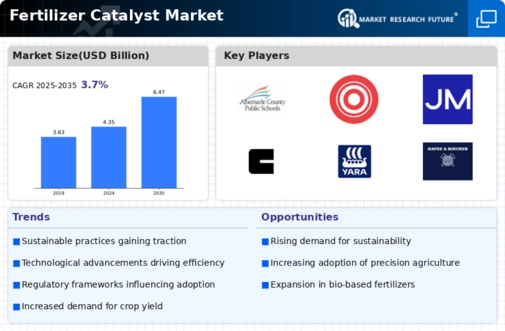Market Trends and Charts
Increasing Agricultural Demand
The Global Fertilizer Catalyst Market Industry is experiencing growth driven by the rising demand for agricultural products. As the global population continues to expand, the need for increased food production becomes paramount. This demand is reflected in the projected market value of 4.35 USD Billion in 2024, with expectations to reach 6.47 USD Billion by 2035. Fertilizer catalysts play a crucial role in enhancing the efficiency of fertilizer production processes, thereby supporting the agricultural sector's ability to meet these demands. The focus on sustainable farming practices further emphasizes the importance of optimizing fertilizer use, which is likely to bolster the market.
Government Regulations and Support
Regulatory frameworks and government support play a significant role in shaping the Global Fertilizer Catalyst Market Industry. Many governments are implementing policies aimed at promoting sustainable agricultural practices and reducing environmental impacts associated with fertilizer use. These regulations often encourage the adoption of advanced fertilizer catalysts that enhance production efficiency while minimizing ecological footprints. Financial incentives, research grants, and subsidies for sustainable practices further stimulate market growth. As governments worldwide prioritize food security and environmental sustainability, the demand for innovative fertilizer catalysts is likely to increase, aligning with global agricultural goals.
Global Economic Growth and Investment
Economic growth across various regions is contributing to the expansion of the Global Fertilizer Catalyst Market Industry. Increased investments in agricultural infrastructure and technology are facilitating the adoption of advanced fertilizer production methods. As economies develop, there is a corresponding rise in agricultural productivity, which necessitates the use of effective fertilizer catalysts. This trend is particularly evident in emerging markets, where investments in agriculture are on the rise. The anticipated growth in market value from 4.35 USD Billion in 2024 to 6.47 USD Billion by 2035 underscores the potential for economic factors to drive demand for fertilizer catalysts.
Rising Focus on Sustainable Agriculture
The Global Fertilizer Catalyst Market Industry is increasingly influenced by the global shift towards sustainable agriculture. Farmers and agricultural producers are seeking ways to enhance productivity while minimizing environmental impacts. Fertilizer catalysts that improve nutrient efficiency and reduce waste are becoming essential tools in achieving these goals. This trend is supported by the growing awareness of the importance of sustainable farming practices, which is likely to drive demand for innovative catalysts. As the industry adapts to these changing preferences, the market is expected to grow, reflecting the broader commitment to sustainable food production.
Technological Advancements in Fertilizer Production
Technological innovations within the Global Fertilizer Catalyst Market Industry are pivotal in enhancing production efficiency and reducing environmental impact. Advanced catalyst formulations and processes are being developed to improve the yield and effectiveness of fertilizers. For instance, the introduction of new catalytic materials can lead to lower energy consumption and reduced greenhouse gas emissions during production. As these technologies evolve, they are expected to drive market growth, potentially contributing to a compound annual growth rate of 3.68% from 2025 to 2035. This trend indicates a shift towards more sustainable and efficient fertilizer production methods.



 Source: Primary Research, Secondary Research, MRFR Database and Analyst Review
Source: Primary Research, Secondary Research, MRFR Database and Analyst Review















